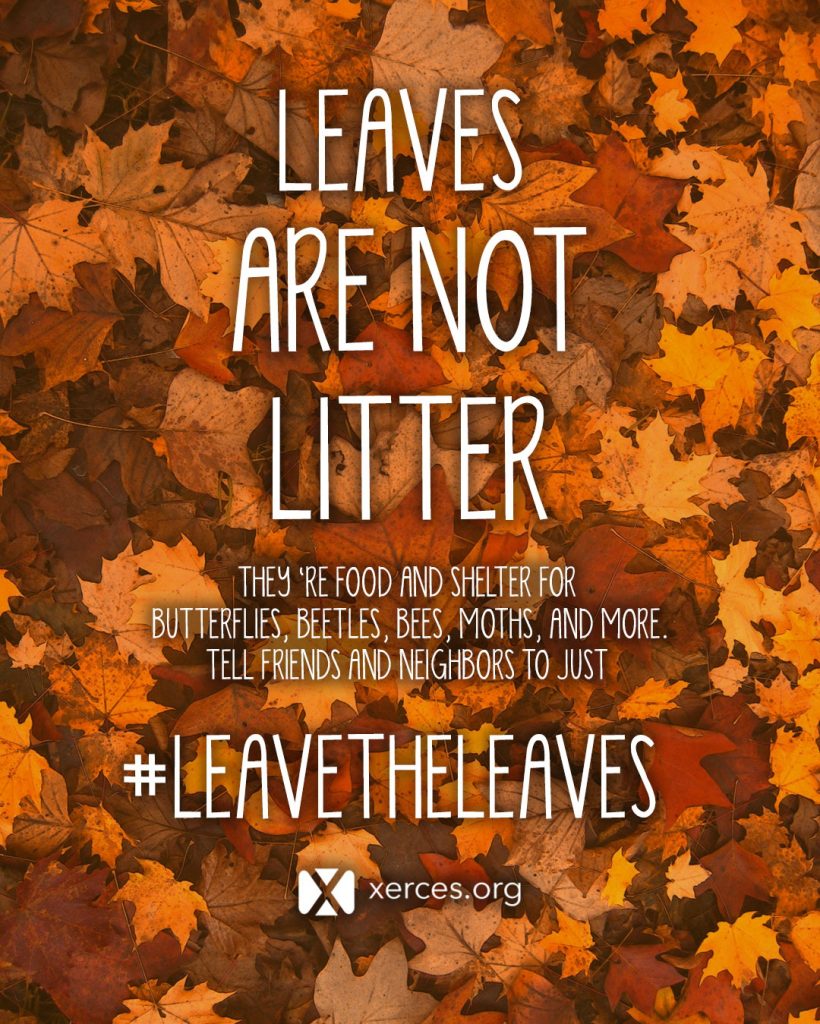Above photo credit: Aaron Siegle
Leave the Leaves!
By Sarah Siegle 2022-2023 Environmental Leader
As the weather cools and the vibrant hues of oranges and reds adorn neighborhood streets, it is evident that autumn is here. Though a picturesque sight to behold, what is the most sustainable thing to do with all the fallen leaves? Contrary to common practice, spending countless hours raking them up and setting aside on the street is not the best solution. If used properly, it is estimated that the leaves of one tree are worth about $50 in plant food and rich soil—about twice the amount of minerals in manure (Boyles, 2022).

Photo Credit: Xerces.org
Leaves are nature’s soil superfood, as they are high in carbon, which creates rich, prosperous soil. When leaves decompose they release nutrients that benefit both the grass and billions of microbes in the soil. Because they are so rich in organic material, they allow more water to percolate into the ground, which can reduce stormwater runoff. This is why forest soils can absorb about 10 to 15 times more rainwater than lawn (Campbell, 2022). Since the U.S. has about 40 million acres of lawn (Wheeler, 2017), extra water absorption from leaf-feed grass will simulate the functioning of the natural ecosystem.
Yard waste including leaves makes up about 13% of the U.S.’s solid waste amounting to 33 million tons per year (Tangley, 2015). This takes up the exhaustible resource of space in landfills. By breaking down along with other waste creates methane, a major contributors to climate change.
By removing and disposing of leaves, the diverse array of insects that thrive on leaf litter also lose their habitat. Beloved pollinators, like butterflies, use leaf litter for overwintering. The Great Spangled Fritillary and Wooly Bear caterpillars, for example, use leaves as protection, while luna moths and swallowtail butterflies camouflage their cocoons in the dried leaves (Wheeler, 2017). Queen bumble bees also burrow into shallow ground and leaves act as a protective blanket. The survival of these insects is vital for the cheery birds, chipmunks, and turtles that rely on caterpillars and larvae to feed their young (Markham, 2020).
To maximize this year’s autumn bounty, here are some suggestions:
1. Mulch the Leaves
By simply leaving your leaves in your lawn and chopping them up with a mulching mower to break them up, you are protecting leaf litter habitat and enriching your lawn’s health. Breaking them up ensures that the lawn will not have any brown spots caused by the leaves blocking the light from reaching the grass. Mulched leaves also help protect root systems, leading to a healthier lawn. When leaves are broken down over time by microorganisms, they will provide about 50 to 80 percent of the nutrients a plant needs from the soil (Campbell, 2022). Your yard will also have an abundance of earthworms and other organisms to aerate the soil.

Photo Credit: Aaron Siegle
2. Boost your Compost
Compost piles create hummus, a rich soil generated by a mix of carbon rich “brown material” and nitrogen rich “green material.” Decaying leaves are prime “brown material” to add to a compost pile, as they add lots of organic matter, nutrients, and especially carbon. When leaves are paired with fresh grass clippings, a nice balance of both carbon and nitrogen is created.
3. Soil Enrichment
Spread leaves over soil or dig them into the top few inches of soil as a nutrient supplement. This free alternative to synthetic fertilizers and pesticides will not only save a trip to the store but will reduce your environmental footprint and preserve the wildlife around your yard. Pine needles, which make the soil more acidic as the decompose, can be integrated into the soil around acidic loving plants (such as rhododendrons, azaleas, and magnolias).
4. Use as Mulch
Leaves can also provide your landscape plants natural fertilizer. Raking your leaves into mulched beds can suppress pesky weeds, saving both effort and time come spring. Aim for a 2 to 3 in layer to protect plant roots over the winter (Cue, n.d.). Additionally, this will help keep the soil moist, reducing the need for watering.
Save the Bay!
By choosing to not rake the leaves for pickup, you are contributing to the health of the Chesapeake Bay. Leaves on the side of the road can block up storm drains and also contribute to nutrient pollution in nearby streams and the bay. This can lead to eutrophication, as excess nutrients will lead to algae blooms, depleting the oxygen in the water, which may lead to the loss of aquatic life.
Save yourself the time and energy of raking countless leaves this fall and make the most of this natural, nutrient rich fertilizer to enhance your lawn, soil, and ecosystem. This will not only improve your lawn health and save money, but will provide habitat and food for pollinators while contributing to a cleaner water supply.
Works Cited
Boyles, M. (2022, October 25). 8 ways to use fall leaves in the garden. Almanac.com. Retrieved November 5, 2022, from https://www.almanac.com/more-ways-use-fall-leaves-garden
Burgess, L. L. (2018, November 7). Fall leaves: To leave or not to leave. Home & Garden Information Center | Clemson University, South Carolina. Retrieved November 6, 2022, from https://hgic.clemson.edu/fall-leaves-to-leave-or-not-to-leave/
Campbell, H. (2022, November 3). Let leaves be: Hibernation season is near! Chesapeake Bay Foundation. Retrieved November 6, 2022, from https://www.cbf.org/blogs/save-the-bay/2022/11/let-leaves-be-hibernation-season-is-near.html
Cue, K. (n.d.). The benefits of Fallen Leaves. The Benefits of Fallen Leaves | Nebraska Extension. Retrieved November 6, 2022, from https://extension.unl.edu/statewide/dodge/the-benefits-of-fallen-leaves/
Environmental Protection Agency. (2022, July 7). Composting at Home. EPA. Retrieved November 6, 2022, from https://www.epa.gov/recycle/composting-home
Iannotti, M. (2021, October 27). 7 things to do with fall leaves. The Spruce. Retrieved November 5, 2022, from https://www.thespruce.com/things-to-do-with-fall-leaves-1402480
Krans, R. (2022, January 21). Don’t sweep your leaves to the curb! mulch them back into your lawn or garden. MSU Extension. Retrieved November 6, 2022, from https://www.canr.msu.edu/news/dont_sweep_your_leaves_to_the_curb_mulch_them_back_into_your_lawn_or_garden
Long, R. (2020, October 8). Raking leaves? drop the rake and stop what you’re doing. Chesapeake Bay Foundation. Retrieved November 5, 2022, from https://www.cbf.org/blogs/save-the-bay/2020/10/raking-leaves-drop-the-rake-and-stop-what-youre-doing.html
Markham, D. (2020, October 22). Skip the rake and leave the leaves for a healthier, Greener Yard. Treehugger. Retrieved November 5, 2022, from https://www.treehugger.com/skip-rake-and-leave-leaves-healthier-greener-yard-4858786
Tangley, L. (2015, October 1). Why you should leave the leaves. National Wildlife Federation. Retrieved November 5, 2022, from https://www.nwf.org/Magazines/National-Wildlife/2015/OctNov/Gardening/Leave-the-Leaves
Wheeler, J. (2017, October 6). Leave the leaves! Xerces Society. Retrieved November 6, 2022, from https://xerces.org/blog/leave-the-leaves
About the Author:
 Sarah Siegle, 2022-2023 Environmental Leader
Sarah Siegle, 2022-2023 Environmental Leader
Sarah is a Junior at Good Counsel High School and part of Bethesda Green’s Environmental Leaders program. She’s always had a passion for the outdoors and wants to protect native ecosystems and biodiversity. She’s particularly interested in incorporating native plants into the landscape, finding ways to reduce her ecological footprint, and studying birds as a key indicator of the health of the environment. She’s excited to implement ways to combat climate change and focus on hope in her own community through the Bethesda Green Program.





